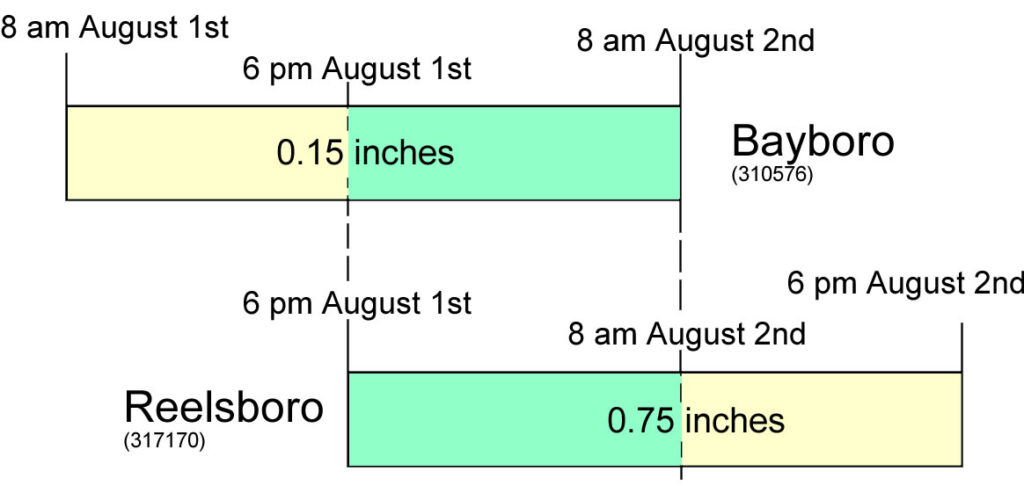If you happened to be curious about how much it rained yesterday, you would probably be looking for how much rain fell on that exact date, from midnight to midnight. TV meteorologists use the same time frame to tell viewers how much rain fell the previous day. However, many weather stations do not operate in this manner. Reporting times for weather stations can vary greatly from station to station.
Why the variation? The most expansive weather reporting network in the country is the National Weather Service’s Cooperative Observer Program (COOP). Most of the weather observers in this program are volunteers, and midnight is not an ideal time for most to go outside and take their daily observation. Therefore, observations are often made at 7 am, making the day on record from 7 am to 7 am.
Even stations within the same network report at different times. An example of this are two COOP stations in Pamlico County, Bayboro and Reelsboro.

On August 2nd, Bayboro reported a rainfall total of 0.15 inches, while Reelsboro reported 0.75 inches. The Bayboro station and the Reelsboro station are separated by 5.6 miles, and while convective summertime storms can produce differing rainfall totals across relatively small distances, the difference is unlikely to be as high as the 0.6 inches in this case. So, why the difference? The difference is most likely caused by differences in the period of reporting between the two stations.
The graphic below shows a side-by-side timeline of the period each station reports for August 2nd. The green periods are times during the reporting day that are similar between both stations. Periods in yellow are times during the reporting day that are not the same as the other station. It is easy to see that, for each station, there are several hours when the other station is not reporting yet both of these observations are designated as August 2nd.

With this discrepancy, there are a few different situations related to when/how much rain actually fell. One possibility is that 0.15 inches fell during the green period between 6 pm on August 1st and 8 am on August 2nd, a period that both stations include, and that the remaining 0.6 inches reported at Reelsboro fell after 8 am.
Another possibility is that no rain fell at all during the time that both stations report as August 2nd. This would mean that the entirety of the rainfall at Bayboro fell before 6 pm on August 1st with a similar situation at Reelsboro, with the total falling after 8 am on August 2nd.
The third scenario is that some amount of rain between 0 and 0.15 inches fell during the window when both stations were reporting, and the remaining rainfall fell in the periods when only one of the stations was reporting.
As you can see, it is impossible, on a daily basis, to compare two stations with such different reporting times, and this difference can be a big problem when daily precipitation totals are reported. So the next time someone asks about daily precipitation, make sure you ask about the reporting time, otherwise you may be really surprised!